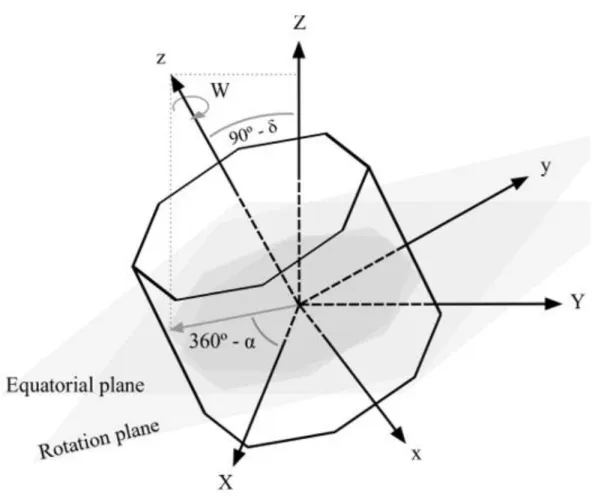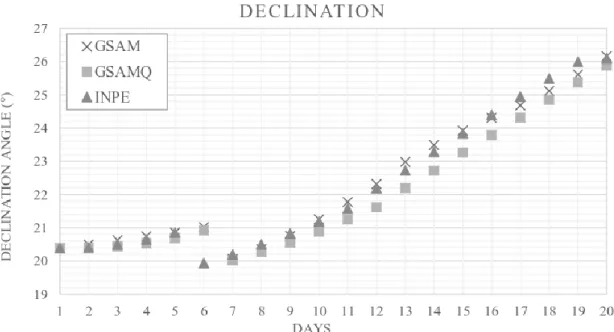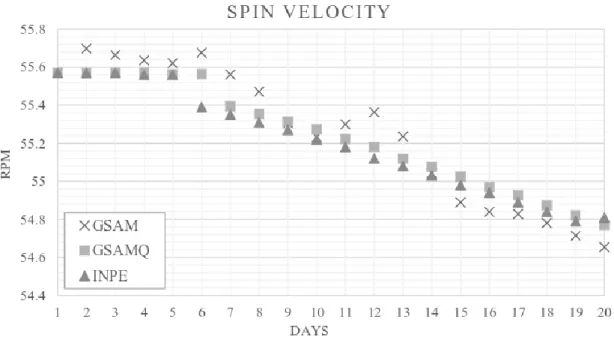Braz. J. of Develop.,Curitiba, v. 6,n 3,p 15648-15663 mar . 2020.ISSN 2525-8761
Influence of geomagnetic field models on analytical propagator for SPIN
stabilized satellites
Influência de modelos de campo geomagnético em analíticos propagador
de satélites estabilizados com SPIN
DOI:10.34117/bjdv6n3-442
Recebimento dos originais: 02/02/2020 Aceitação para publicação:27/03/2020
Maria Cecília Zanardi
Doutora em engenharia Aeronaútica e Mecânica Instituto Tecnológico de Aeonáutica
Instituicção: Centro de Engenharia, Modelagem e Cienciesas Sociais Aplicadas Universidade Federal do ABC - UFABC, Santo André, SP
Endereço:Av.dos Estados – 5007 – Bangú-Santo André – SP, Brasil, 09210-580 E-mail: mceciliazanardi@gmail.com.br
Victor Mota
Bacharel em Ciencia e Tecnologia
Universidade Federal do ABC - UFABC, Santo André, SP Instituicção: Universidade Federal do ABC - UFABC, Santo André, SP Endereço:Av.dos Estados – 5007 – Bangú-Santo André – SP, Brasil, 09210-580
E-mail: victor14mota@gmail.com
ABSTRACT
This work explores the impacts of using dipole or quadrupole models for Earth’s magnetic field when an analytical propagator calculates residual and eddy current torques on spin-stabilized satellites. Comprising the gravity gradient, solar radiation pressure, aerodynamic, and the aforementioned torques, the propagators used data from Brazilian satellites SCD1 and SCD2, provided by the National Institute for Space Research (INPE). Ranging about two decades in total, the selected simulation periods had their respective initial data propagated by both programs and then compared with actual data from the satellites, both updating the simulation with new daily data and not. The first propagator, called GSAM, which uses the dipole model to calculate the magnetic torques, was used to screen for simulation periods due to its swift running time. The second propagator uses the quadrupole model and is called GSAMQ. The mean deviations for the spin velocity, right ascension and declination angles were compared for both satellites, which showed that the programs better predict the spatial orientation of satellite SCD2 over SCD1, especially GSAMQ. It is also
Braz. J. of Develop.,Curitiba, v. 6,n 3,p 15648-15663 mar . 2020.ISSN 2525-8761
demonstrated that the programs’ precision heavily relies on the initial data, suggesting that a statistical approach of GSAMQ’s performance could shed more light on its accuracy.
Keywords: Analytical Propagators, Artificial Satellites, Environmental Torques, Satellite Attitude.
RESUMO
Este trabalho explora os impactos do uso de modelos dipolo ou quadrupolo no campo magnético da Terra quando um propagador analítico calcula torques de corrente residual e de fuga em satélites estabilizados por rotação. Compreendendo o gradiente de gravidade, a pressão de radiação solar, os aerodinâmicos e os torques mencionados, os propagadores utilizaram dados dos satélites brasileiros SCD1 e SCD2, fornecidos pelo Instituto Nacional de Pesquisas Espaciais (INPE). Com duração aproximada de duas décadas, os períodos de simulação selecionados tiveram seus respectivos dados iniciais propagados pelos dois programas e depois comparados com os dados reais dos satélites, ambos atualizando a simulação com novos dados diários e não. O primeiro propagador, chamado GSAM, que usa o modelo dipolo para calcular os torques magnéticos, foi usado para rastrear períodos de simulação devido ao seu rápido tempo de execução. O segundo propagador usa o modelo quadrupolo e é chamado GSAMQ. Os desvios médios dos ângulos de velocidade de rotação, ascensão reta e declinação foram comparados para ambos os satélites, o que mostrou que os programas preveem melhor a orientação espacial do satélite SCD2 sobre o SCD1, especialmente o GSAMQ. Também é demonstrado que a precisão dos programas depende muito dos dados iniciais, sugerindo que uma abordagem estatística do desempenho da GSAMQ poderia lançar mais luz sobre sua precisão.
Palavras-chave: Propagadores Analíticos, Satélites Artificiais, Torques Ambientais, Atitude
por Satélite.
1 INTRODUCTION
Artificial satellites have had essential roles in space missions and impacted life on Earth for decades, whose applications rely directly on their position and orientation. Once in space, they are subject to different types of external forces that can alter their movement, making the theoretical analysis of the equation system that describes their motion extremely relevant, in order to prevent and potentially correct any deviation that could affect the mission. This work is focused on satellites with low eccentricity orbits and spin stabilization, characterized by rotation around the axis of greatest principal moment of inertia.
The main sources of perturbation for these satellites (Zanardi et al., 2016) are the aerodynamic torque (AT), caused by collision between molecules from the high atmosphere with the satellite’s surface; the solar radiation torque (SRT), consequence of the variation of
Braz. J. of Develop.,Curitiba, v. 6,n 3,p 15648-15663 mar . 2020.ISSN 2525-8761
momentum of incident photons hitting the surface of the satellite; the gravity gradient torque (GGT), derived from the Earth’s gravity force attracting the satellite’s non-uniformly distributed mass; the residual magnetic torque (RMT), result of the interaction between the magnetic moment over the rotation axis of the satellite and the geomagnetic field; and, lastly, the eddy currents torque (ECT), originated from the interaction between small induced currents on metal parts of the satellite and Earth’s magnetic field.
Components of each torque must be included in the movement equations for the attitude of spin stabilized satellites and in order to calculate them a mathematical model is required. In this work, the geomagnetic field is modeled using the Dipole or Quadrupole models, based on the truncation of the spherical harmonics series that describes the potential (Garcia, 2007). The models for each torque are introduced and discussed in (Wertz, 1978) and (Zanardi et al., 2018).
2 ROTATIONAL MOTION EQUATIONS AND ANALYTICAL SOLUTION
The equations that describe the rotational motion of spin stabilized satellites (Wertz, 1978; Kuga et al., 1987) are given in terms of the right ascension angle, the rotation axis declination angle and the absolute value of the spin velocity. These variables are defined based on the satellite and equatorial reference frames, as shown is Figure 1.
Braz. J. of Develop.,Curitiba, v. 6,n 3,p 15648-15663 mar . 2020.ISSN 2525-8761
Figure 1. Satellite and equatorial reference frames.
Introduced in (Kuga et al., 1987), they depend on the external torque components acting on the satellite’s fixed system and on the greatest moment of inertia around the axis of rotation. The rotational motion equations are given in 1, 2, and 3.
𝑑𝛼 𝑑𝑡 = 𝑁𝑥 𝐼𝑧𝑊 cos 𝛿 𝑑𝛿 𝑑𝑡 = 𝑁𝑦 𝐼𝑧𝑊 𝑑𝑊 𝑑𝑡 = 𝑁𝑧 𝐼𝑧
where 𝐼𝑧 is the axis of greatest principal moment of inertia around the spin axis and 𝑁𝑥, 𝑁𝑦,
Braz. J. of Develop.,Curitiba, v. 6,n 3,p 15648-15663 mar . 2020.ISSN 2525-8761
(Motta, 2014; Zanardi et al., 2018) introduce an analytical solution for the rotational motion equations, valid for an orbital period and composed by the mean components of TA, GGT, SRT, ECT and RMT. 𝑊 = (𝑊0+ 𝑁𝐺𝐺𝑧 𝑁𝐸𝐶𝑧 ) 𝑒𝑁𝐸𝐶𝑧𝐼𝑧 𝑡−𝑁𝐺𝐺𝑧 𝑁𝐸𝐶𝑧 𝛿 = 𝑡 𝐼𝑧 (𝑁𝐸𝐶𝑦− 𝑁𝑦𝑠𝑁𝐸𝐶𝑧 𝑁𝐺𝐺𝑧 ) + 𝑁𝑦𝑠 𝑁𝐺𝐺𝑧 ln (𝑊 𝑊0 ) + 𝛿0 𝛼 = 𝑡 𝐼𝑧cos 𝛿̅ (𝑁𝐸𝐶𝑥− 𝑁𝑥𝑠𝑁𝐸𝐶𝑧 𝑁𝐺𝐺𝑧 ) + 𝑁𝑥𝑠 𝑁𝐺𝐺𝑧cos 𝛿̅ ln (𝑊 𝑊0 ) + 𝛼0
where, in equation (4), 𝑊 is the spin velocity in rad/s, 𝑊0 is the initial value for the spin velocity, 𝑁𝐺𝐺𝑧 and 𝑁𝐸𝐶𝑧 are the components in the 𝑧-axis for the gravity gradient and the eddy currents torques, respectively. In equation (5), 𝑁ECy and 𝑁𝑦𝑠 are the components in 𝑦 for the eddy currents torque and the sum of components of torques in the 𝑦-axis that do not multiply by 𝑊, respectively, while 𝛿0 is the initial value for the rotation axis declination. Lastly, in equation (6), 𝛿̅ is the average between the calculated declination and its initial value, 𝑁𝑥𝑠 is the sum of components of torques in the 𝑥-axis that do not multiply by 𝑊,
while
𝛼0 is the initial value for the rotation axis declination.
(Motta, 2014) develops the GSAM propagator, composed by the aforementioned torques and using the dipole model for the geomagnetic field. Subsequently, (Zanardi et al., 2018) replaced the magnetic model by the quadrupole, naming the new propagator GSAMQ and comparing the results. Both works had only 40 days of satellite orbit and attitude data available, limiting the validation of both programs.
Therefore, the objective of this work is to extend the study of both propagators for new simulation intervals, since two decades of data were recently provided by the National Institute for Space Research (INPE). Once adapted to simulate several periods, the propagators had their results compiled and compared, checking if they attended the required precision of 0.5° for the right ascension and declination angles and 0.5 𝑟𝑝𝑚 for the spin
Braz. J. of Develop.,Curitiba, v. 6,n 3,p 15648-15663 mar . 2020.ISSN 2525-8761 3METHODOLOGY
In order to compare the precision of both models in making analytic predictions, they were programmed to work the in same way, except for the magnetic torques. That way, any variation in the mean deviations would be a consequence of different magnitudes between the torques in question.
The daily update, as the name indicates, regards how the program is going to use the data provided. In case it is daily updated, the satellite attitude will be propagated for 24 hours, stored then replaced by data from the following day to be propagated for another 24 hours, continuing this logic until the 20 day interval is fully simulated. In case it is decided to not update the data daily, the program will use its own results after the first day and continue onto the next one, carrying on the errors and consequently increasing imprecision of the results.
Intending to standardize the simulations, all daily updated intervals were set to 20 days long, matching the ones used to validate the GSAM propagator (Mota e Zanardi, 2018). By doing that, it is possible to directly compare the performance of both programs, for intervals with and without daily updates.
Although results with low deviations could be found by choosing intervals arbitrarily, a way to increase fidelity to the study was to always use the same day to start simulations with and without daily updates, making the comparison of the results easier.
4 RESULTS
Altogether, combining both satellites and data update modes, 140 simulations were made using MATLAB software. The mean deviations for the right ascension angle, the rotation axis declination angle and the spin velocity were compiled in a spreadsheet and compared. Due to the large amount of results, only three intervals per simulation category were selected to be showcased in this work.
Tables 1 and 2 show the mean deviations for the variables calculated for satellite SCD1, with and without daily updates, respectively. Although the GSAMQ propagator had an even lower mean deviation for the spin velocity, the attitude angles tended to have their mean deviations increased in all simulations, mainly the right ascension, exceeding the required precision.
Braz. J. of Develop.,Curitiba, v. 6,n 3,p 15648-15663 mar . 2020.ISSN 2525-8761
Table 1. Intervals simulated for the SCD1 satellite with daily data updates.
GSAM GSAMQ
Intervals Δα(°) Δδ(°) W(rpm) Δα(°) Δδ(°) W(rpm)
10/28/1995 - 11/16/1995 [20 days] -0.14037 -0.04807 -0.05485 0.64217 0.29729 -0.03622
10/07/1998 - 10/26/1998 [20 days] -0.22206 0.28845 0.01139 0.76857 0.30528 0.00620 03/30/2011 - 04/18/2011 [20 days] -0.22782 -0.36204 -0.04587 0.96131 -0.46086 -0.02101
Table 2. Intervals simulated for the SCD1 satellite without daily data updates.
GSAM GSAMQ
Intervals Δα(°) Δδ(°) W(rpm) Δα(°) Δδ(°) W(rpm)
10/28/1995 - 11/01/1995 [5 days] 0.07738 -0.41353 -0.35120 171.477 -0.01932 -0.04168 07/18/2000 - 07/20/2000 [3 days] -0.38526 0.19135 -0.11972 200.088 0.44852 0.06516 04/19/2003 - 04/21/2003 [3 days] -0.22399 -0.16082 -0.15237 186.954 -0.43518 -0.07262
In order to compare the results for GSAM and GSAMQ with actual data, the temporal variation of spin velocity, right ascension and declination of the spin axis are show in the Figures 2, 4 and 6 for the first interval (10/28/1995 – 11/16/1995) and with daily data updates. Figures 3, 5 and 7 show the deviations and the mean deviations by GSAM and GSAMQ propagators for each variable.
By Figures 2 and 3, regarding the right ascension angle, it can be verified that although the behavior of the curve agrees with the real data, the GSAMQ values for deviations do not achieve 0.5° INPE’s standards, as shown in Table 1. Analyzing Figures 4 and 5, the declination of the spin axis showed satisfactory results, with values within INPE standards.
However, for the spin velocity (Figures 6 and 7), the GSAMQ results are better than GSAM, and both have values within INPE standards. This happens due to the great influence of ECT in the spin velocity. Similar results were discussed in Zanardi et al. (2018) for another interval.
Braz. J. of Develop.,Curitiba, v. 6,n 3,p 15648-15663 mar . 2020.ISSN 2525-8761
Figure 2. Right ascension angle for the SCD1 satellite with data updates, from 10/28/1995 to 11/16/1995
Figure 3. Right ascension angle deviations for the SCD1 satellite with data updates, from 10/28/1995 to 11/16/1995
Braz. J. of Develop.,Curitiba, v. 6,n 3,p 15648-15663 mar . 2020.ISSN 2525-8761
Figure 4. Declination angle for the SCD1 satellite with data updates, from 10/28/1995 to 11/16/1995
Braz. J. of Develop.,Curitiba, v. 6,n 3,p 15648-15663 mar . 2020.ISSN 2525-8761
Figure 6. Spin velocity for the SCD1 satellite with data updates, from 10/28/1995 to 11/16/1995
Figure 7. Spin velocity deviations for the SCD1 satellite with data updates, from 10/28/1995 to 11/16/1995
For the SCD2, GSAMQ’s performance turned out to be better than GSAM’s for the majority of the simulations, for both update modes. The results on tables 3 and 4 for the SCD2 show a consistent improvement for all three parameters in focus, not only attending
Braz. J. of Develop.,Curitiba, v. 6,n 3,p 15648-15663 mar . 2020.ISSN 2525-8761
the required precision but lowering the mean deviations even more for part of the simulations.
Table 3. Intervals simulated for the SCD2 satellite with daily data updates.
GSAM GSAMQ
Intervals Δα(°) Δδ(°) W(rpm) Δα(°) Δδ(°) W(rpm)
07/18/2000 - 08/06/2000 [20 days] 0.45507 0.27520 0.14087 0.05713 0.03630 -0.04755
09/28/2008 - 10/17/2008 [20 days] 0.36957 0.20790 -0.01980 -0.11508 0.05288 -0,11029 01/10/2012 - 01/29/2012 [20 days] -0.13641 0.02856 -0.07257 0.01702 0.07405 -0.00600
Table 4. Intervals simulated for the SCD2 satellite without daily data updates.
GSAM GSAMQ
Intervals Δα(°) Δδ(°) W(rpm) Δα(°) Δδ(°) W(rpm)
10/27/2001 - 10/29/2001 [3 days] 0.12642 -0.01798 -0.01820 0.04966 0.01484 -0.01681 09/28/2008 - 09/30/2008 [3 days] 0.34838 0.44847 0.08860 0.45082 0.15634 -0.00482 01/10/2013 - 01/12/2013 [3 days] 0.27716 0.18341 -0.09206 0.27132 0.02089 -0.00660
Figures 8, 10 and 12 show how the variables calculated by GSAM and GSAMQ evolve over time from 07/18/2000 to 08/06/2000, being simulated with daily data updates. Figures 9, 11 and 13 show the deviations and the mean deviations by GSAM and GSAMQ propagators for each variable.
By Figures 8 and 9, and Table 3, for the GSAMQ propagator the mean deviation for right ascension is 0.05713 and all deviations are smaller than 0.5° for each day. By Figures 10 and 11, the mean deviation for the declination is smaller than 0.5° for both propagators,
and only for two days (11 and 12) the deviations are greater than 0.5° for GSAM. By Figures 12 and 13, the mean deviation and all the deviations for the spin velocity are smaller than 0.5 𝑟𝑝𝑚, but it is possible to observe the best behavior for the GSAMQ propagator.
Some days in the graphs have all three data points coinciding. This can be attributed to the actuation of attitude control system aboard the SCD2 satellite and the fact that it is not included in the theory behind the calculations. Thus, every time a control maneuver is performed by INPE, the simulation restarts using as initial conditions the new data after the maneuver. For the considered interval, it is possible to observe two control actions: days 8 and 15.
Braz. J. of Develop.,Curitiba, v. 6,n 3,p 15648-15663 mar . 2020.ISSN 2525-8761
Figure 8. Right ascension angle for the SCD2 satellite with data updates, from 07/18/2000 to 08/06/2000
Figure 9. Right ascension angle deviations for the SCD2 satellite with data updates, from 07/18/2000 to 08/06/2000
Braz. J. of Develop.,Curitiba, v. 6,n 3,p 15648-15663 mar . 2020.ISSN 2525-8761
Figure 10. Declination angle for the SCD2 satellite with data updates, from 07/18/2000 to 08/06/2000
Figure 11. Declination angle deviations for the SCD2 satellite with data updates, from 07/18/2000 to 08/06/2000
Braz. J. of Develop.,Curitiba, v. 6,n 3,p 15648-15663 mar . 2020.ISSN 2525-8761
Figure 12. Spin velocity for the SCD2 satellite with data updates, from 07/18/2000 to 08/06/2000
Braz. J. of Develop.,Curitiba, v. 6,n 3,p 15648-15663 mar . 2020.ISSN 2525-8761 5 CONCLUSIONS
From the data obtained, it is possible to infer that the use of different geomagnetic models affected the results indirectly, with significant variations between the satellites. For the GSAMQ, even though the mean deviation for the spin velocity tended to decrease, the right ascension angle was problematic once again (Motta, 2014). The mean deviation for the rotation axis declination had the same precision across propagators, having poorer performances only for the SCD1 simulations without daily updates.
In general, the SCD2 simulations generated results that more closely matched the real satellite data. This fact can be attributed to the presence of attitude control aboard the SCD2, resulting in zero deviation for the days in which active control is used, since the propagators are not equipped to model such changes in the satellite’s attitude.
The right ascension angle is mostly influenced by the solar radiation torque, the aerodynamic torque and the gravity gradient torque. The subpar performance in predicting this angle can be traced to how the programs calculate the torques. GSAM uses the dipole model, calculating all the torques at the same time, considering the interaction of all variables changing over the orbital period, 14 times a day. GSAMQ, for instance, uses the quadrupole model for the magnetic torques but calculates them separately, before all the other torques. This is due to the computational power required to calculate the eddy current torques using a more sophisticated magnetic model, making it unfeasible to be calculated with the rest of the torques.
Therefore, the implementation of GSAM can be improved by including the magnetic torques using the quadrupole model when calculating all the torques at the same time, demanding more computational power and time but . Lastly, it is also suggested that a statistical study to compare the deviations for both satellites throughout the two decades of data available, possibly corroborating the direct relation between more refined magnetic models and consequent improvement of results.
ACKNOWLEDGMENTS
Braz. J. of Develop.,Curitiba, v. 6,n 3,p 15648-15663 mar . 2020.ISSN 2525-8761 REFERENCES
Garcia, R.V., 2007. Satélites Estabilizados por Rotação e o Torque Magnético Residual. Tese de Mestrado, Universidade Estadual Paulista, Guaratinguetá, Brasil.
Kuga, H.K., Ferreira, L.D. e Guedes, U.T., 1987. “Simulação de atitude e de manobras para o satélite brasileiro estabilizado por rotação”. Relatório Técnico, INPE-4271-PRE/1143. Mota, V. e Zanardi, M.C., 2018. “Validação do propagador de atitude gsam de satélites estabilizados por rotação para diferentes períodos de simulação”. Proceeding Series of the Brazilian Society of Computational and Applied Mathematics, Vol. 6, No. 1.
Motta, G.B., 2014. Predição Analítica do Movimento Rotacional de Satélites Estabilizados. Tese de Mestrado, Universidade Estadual Paulista, Guaratinguetá, Brasil.
Wertz, J.R., 1978. Spacecraft Attitude Determination and Control. Springer Science and Business Media, London, UK.
Zanardi, M.C., Celestino, C.C., Motta, G.B., França, E.M. e Garcia, R.V., 2018. “Analysis of analytical attitude propagators for spin stabilized satellites”. Computational and Applied Mathematics, Vol. 37, pp. 96–109.
Zanardi, M.C., Orlando, V., Motta, G.B., Pelosi, T. e Silva, W.R., 2016. “Numerical and analytical approach for the spin-stabilized satellite attitude propagation”. Computational and Applied Mathematics, Vol. 1, pp. 1–13.






